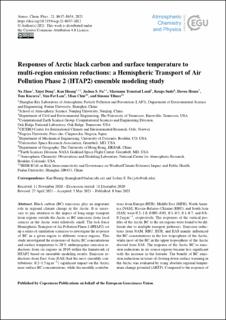| dc.description.abstract | Black carbon (BC) emissions play an important role in regional climate change in the Arctic. It is necessary to pay attention to the impact of long-range transport from regions outside the Arctic as BC emissions from local sources in the Arctic were relatively small. The task force Hemispheric Transport of Air Pollution Phase 2 (HTAP2) set up a series of simulation scenarios to investigate the response of BC in a given region to different source regions. This study investigated the responses of Arctic BC concentrations and surface temperature to 20 % anthropogenic emission reductions from six regions in 2010 within the framework of HTAP2 based on ensemble modeling results. Emission reductions from East Asia (EAS) had the most (monthly contributions: 0.2–1.5 ng m−3) significant impact on the Arctic near-surface BC concentrations, while the monthly contributions from Europe (EUR), Middle East (MDE), North America (NAM), Russia–Belarus–Ukraine (RBU), and South Asia (SAS) were 0.2–1.0, 0.001–0.01, 0.1–0.3, 0.1–0.7, and 0.0–0.2 ng m−3, respectively. The responses of the vertical profiles of the Arctic BC to the six regions were found to be different due to multiple transport pathways. Emission reductions from NAM, RBU, EUR, and EAS mainly influenced the BC concentrations in the low troposphere of the Arctic, while most of the BC in the upper troposphere of the Arctic derived from SAS. The response of the Arctic BC to emission reductions in six source regions became less significant with the increase in the latitude. The benefit of BC emission reductions in terms of slowing down surface warming in the Arctic was evaluated by using absolute regional temperature change potential (ARTP). Compared to the response of global temperature to BC emission reductions, the response of Arctic temperature was substantially more sensitive, highlighting the need for curbing global BC emissions. | en_US |

